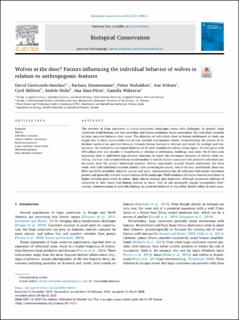| dc.contributor.author | Sanchez, David Carricondo | |
| dc.contributor.author | Zimmermann, Barbara | |
| dc.contributor.author | Wabakken, Petter | |
| dc.contributor.author | Eriksen, Ane | |
| dc.contributor.author | Milleret, Cyril Pierre | |
| dc.contributor.author | Ordiz, Andres | |
| dc.contributor.author | Sanz-Pérez, Ana | |
| dc.contributor.author | Wikenros, Camilla | |
| dc.date.accessioned | 2020-11-16T15:41:11Z | |
| dc.date.available | 2020-11-16T15:41:11Z | |
| dc.date.created | 2020-07-31T10:07:56Z | |
| dc.date.issued | 2020 | |
| dc.identifier.citation | Biological Conservation. 2020, 244, 108514 | en_US |
| dc.identifier.issn | 0006-3207 | |
| dc.identifier.uri | https://hdl.handle.net/11250/2688099 | |
| dc.description.abstract | The recovery of large carnivores in human-dominated landscapes comes with challenges. In general, large carnivores avoid humans and their activities, and human avoidance favors coexistence, but individual variation in large carnivore behavior may occur. The detection of individuals close to human settlements or roads can trigger fear in local communities and in turn demand management actions. Understanding the sources of individual variation in carnivore behavior towards human features is relevant and timely for ecology and conservation. We studied the movement behavior of 52 adult established wolves ((Canis lupus), 44 wolf pairs) with GPS-collars over two decades in Scandinavia in relation to settlements, buildings, and roads. We fit fine-scale movement data to individual step selection functions to depict the movement decisions of wolves while travelling, and then used weighted linear mixed models to identify factors associated with potential individual pair deviations from the general behavioral patterns. Wolves consistently avoided human settlements and main roads, with little individual variation. Indeed, after correcting for season, time of the day, and latitude, there was little variability in habitat selection among wolf pairs, demonstrating that all wolf pairs had similar movement pattern and generally avoided human features of the landscape. Wolf avoidance of human features was lower at higher latitudes particularly in winter, likely due to seasonal prey migration. Although occasional sightings of carnivores or their tracks near human features do occur, they do not necessarily require management intervention. Communication of scientific findings on carnivore behavior to the public should suffice in most cases. | en_US |
| dc.language.iso | eng | en_US |
| dc.rights | Attribution-NonCommercial-NoDerivatives 4.0 Internasjonal | * |
| dc.rights.uri | http://creativecommons.org/licenses/by-nc-nd/4.0/deed.no | * |
| dc.title | Wolves at the door? Factors influencing the individual behavior of wolves in relation to anthropogenic features | en_US |
| dc.type | Peer reviewed | en_US |
| dc.type | Journal article | en_US |
| dc.description.version | publishedVersion | en_US |
| dc.source.volume | 244 | en_US |
| dc.source.journal | Biological Conservation | en_US |
| dc.identifier.doi | 10.1016/j.biocon.2020.108514 | |
| dc.identifier.cristin | 1821099 | |
| dc.source.articlenumber | 108514 | en_US |
| cristin.ispublished | true | |
| cristin.fulltext | original | |
| cristin.qualitycode | 2 | |

